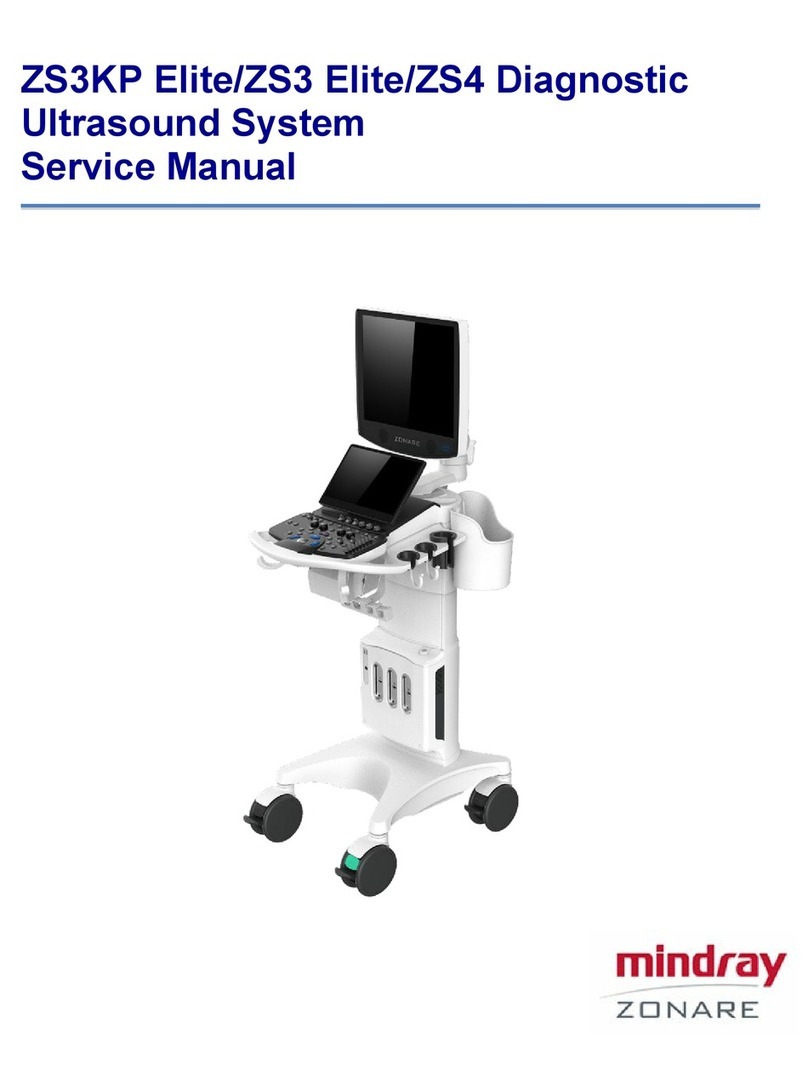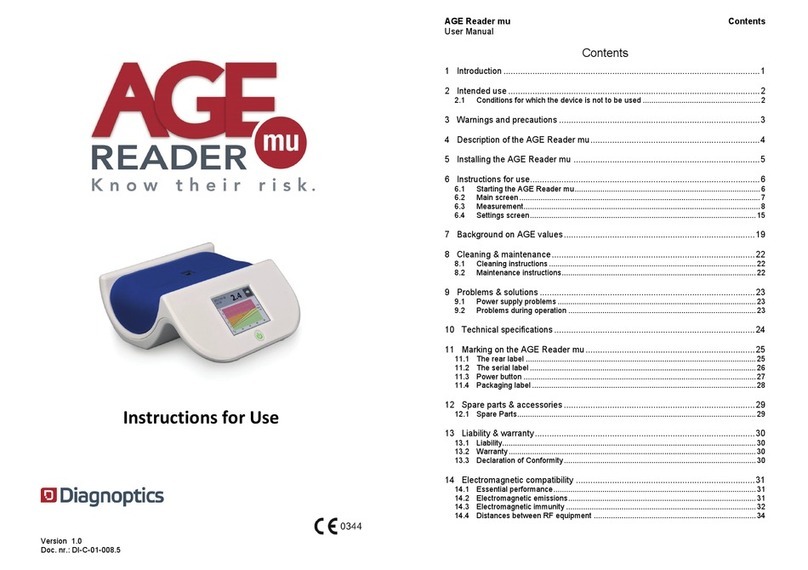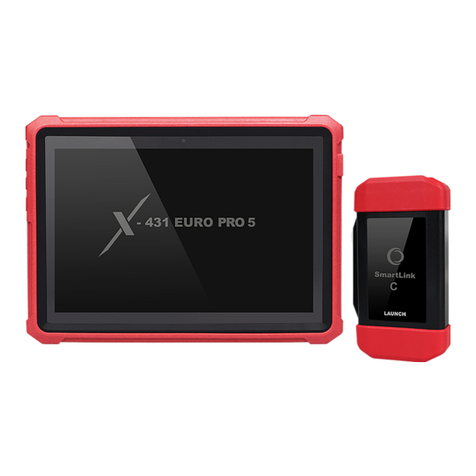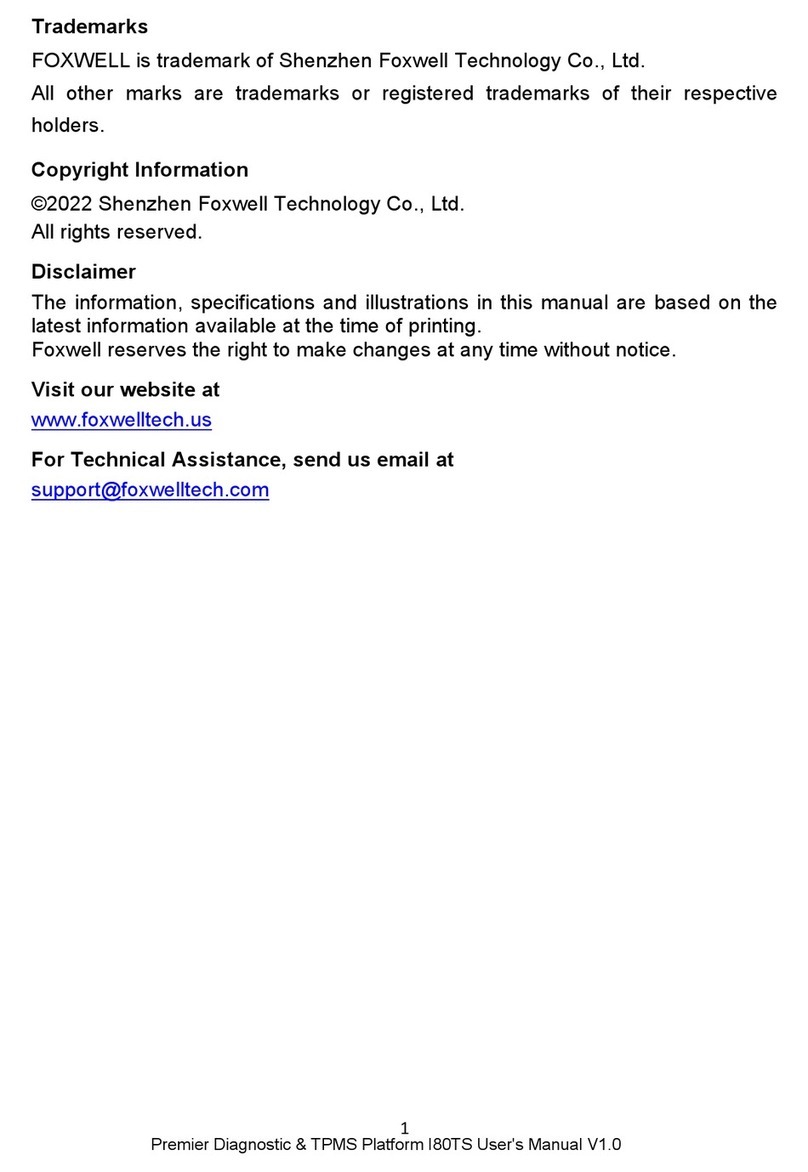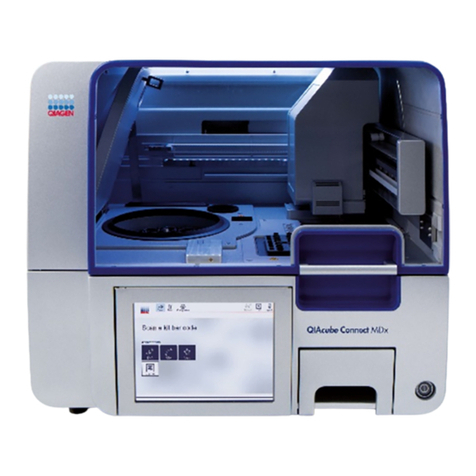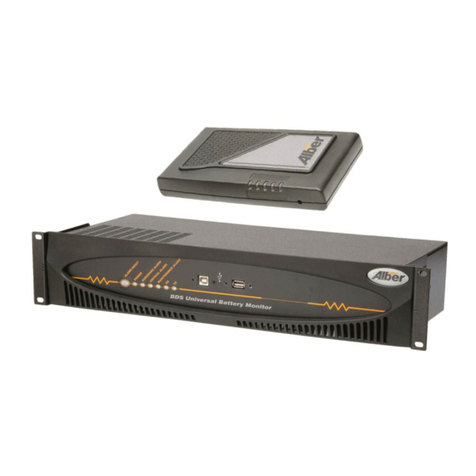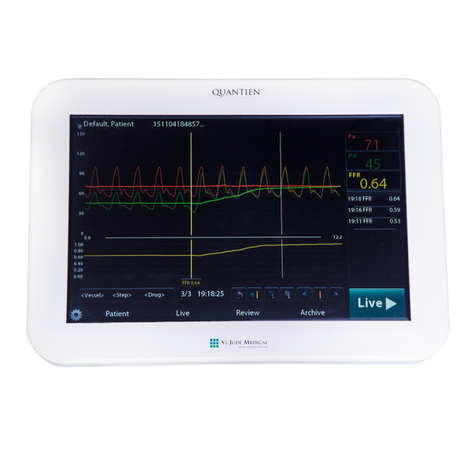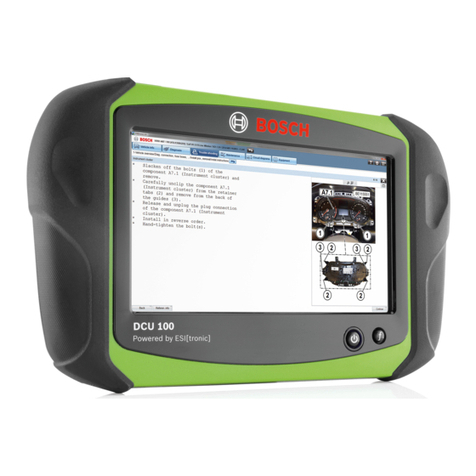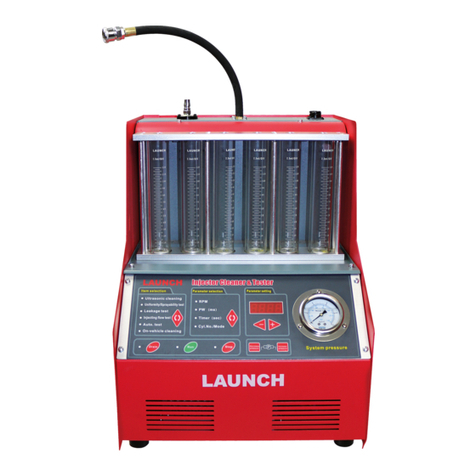Ripley MILLER VIS300C User manual

VIS300C
Standalone Fiber Inspection Kit
User Guide

Page 2
VIS300C InSpec User Guide
Introduction
Important Safety information
Hardware Overview
VIS400 Overview
Built in Power Meter Overview
UPM100 Overview
RP560 Overview
Generic OPM Testing
Ooading from a Power Meter
Generic Scope Single Fiber Testing
Generic Scope MPO Testing
Color Code Creation
Updateing the Software
Report Settings
Project Management
Exporting Projects
Generating Reports
Ooading Reports Over Micro USB
Ooading ReportsWith a Flash Drive
Certications and Contact Information
Contents

Page 3
VIS300C InSpec User Guide
Introduction
The VIS400C is an all-in-one ber test solution for eld and desktop applications. This guide will serve
as a manual to outline the major features of the VIS300C and provide guidance in the use of those
features to generate accurate, and complete reports.
Read and understand all of the instructions and safety
information in this manual before operating this tool.
Analyzed Images from the VIS400 using the VIS300C

Page 4
VIS300C InSpec User Guide
Important Safety Information
Read and understand all of the instructions and safety
information in this manual before operating this tool.
Laser Hazard
Avoid eye exposure to open ber connectors and interfaces
when working with ber systems. They may be connected to
a live laser source.
Do not look into the output port of a laser source.
Point ber endfaces toward non-reective surfaces to
prevent reection of laser.
Electric Shock Hazard
Pay attention to proper battery polarity. Do not mix battery
types or manufacturers.
Do not open the unit with the exception of the battery
compartment door.
Use this unit only for its intended purpose as outlined in this
document.
Damage to Item Hazard
Do not leave item in direct sunlight or near heat sources,
submerge in water, or subject unit to strong impact.
Cover the ber interface with the ip-cap when not in use.
Do not throw this product away.
Contact your local recycling station to dispose of properly.

Page 5
VIS300C InSpec User Guide
Hardware Overview
Variants
The VIS300C has three dierent variants with dierent part numbers. These each target a dierent
market and you should consider which unit meets your requirements.
Variant One VIS300C
The VIS300C Base model is an inspection-only device. This model is ideal for users who need a eld-
viewing device for ber connectors or who need to inspect, grade, and save many ber connector
images very quickly.
Variant Two VIS300C-PM-02-V
The VIS30)C-PM-02-V is an all-in-one test and inspection system. An on-board optical power meter
(OPM) and visual fault locator(VFL) bring extra functionality to the device. The InGaas detector in the
power meter on this model makes it ideal for most users who need to test dB loss on single mode
and multi-mode ber at test sites, such as on cell towers and in central oce settings. The red laser in
the VFL provides fault detection and continuity testing on ber runs up to 5 km.
Variant Three VIS300C-PM-04-V
The VIS300C-PM-04-V is an all-in-one test and inspection system. An on-board OPM and VFL bring
extr functionality to the device. The ltered InGaAs detector in the power meter on this model makes
it ideal for users who need to test the output of high-powered transmit equipment at remote sites,
such as at the ONT or OLT for FTTH applications. The red laser in the VFL provides fault detection and
continuity testing on ber runs up to 5km.
VIS300C Variant Summary
Part Number Functions Common Uses Adapters/Accessories included Hardware Notes
VIS300C
• Base Model
• Automatic Analysis
• Report Generation
• Inspection only jobs
• 1.25 mm Inspection Tip
• 2.5 mm Inspection Tip
• LC Bulkhead Inspection Tip
• SC Bulkhead Inspection Tip
• Comes with a VIS400 that is
compatible with the Desk-
top InSpec software aswell.
• 5" touch screen monitor
housed in a protective case.
VIS300C-PM-02-V
• Automatic Analyosis
• Low Power OPM
• Visual Fault Locator
• Report Generation
• Fiber to the antenna
• Central oce
• 1.25 mm Inspection Tip
• 2.5 mm Inspection Tip
• LC Bulkhead Inspection Tip
• SC Bulkhead Inspection Tip
• 2.5 mm OPM Adapter
• 2.5 mm VFL port
• Comes with a VIS400 that is
compatible with the Desk-
top InSpec software aswell.
• 5" touch screen monitor
housed in a protective case.
• -2 indicates a InGaAs detec-
tor in the opm which gives
a measurement range of +6
to -60 dbm.
• The VFL is a 635nm visible
red laser.
VIS300C-PM-04-V
• Automatic Analysis
• Higher Power OPM
• Visual Fault Locator
• Report Generation
• Fiber to the home
• Cable TV
• Fiber to the premises
• 1.25 mm Inspection Tip
• 2.5 mm Inspection Tip
• LC Bulkhead Inspection Tip
• SC Bulkhead Inspection Tip
• 2.5 mm OPM Adapter
• 2.5 mm VFL port
• Comes with a VIS400 that is
compatible with the Desk-
top InSpec software aswell.
• 5" touch screen monitor
housed in a protective case.
• -04 indicates a ltered
InGaAs detector in OPM
Measurement range of
Filtered InGaAs detector is
+23 to -40 dbm
• The VFL is a 635nm visible
red laser.

Page 6
VIS300C InSpec User Guide
1). The VFL Port (Available on the VIS300C-PM-02-V and VIS300C-PM-04-V) provides the physicial
interface for connecting ber jumpers to the VIS300C for the purposes of fault detection and
continuity testing. the 2.5mm universal interface allows for direct connection of bers to the 635nm 1
mW red laser.
2).The Power meter port avaialble on the -02 and -04 models provides a physical interface for
connecting patch cord jumpers to the VIS300C for the purpose of measuring the absolute or relative
optical power pressent. The OPm has user replaceable adapters for many dierent ber types
including universal 2.5mm and 1.25mm adapters.
3).The Micro USB Port provides an interface for transferring data from the VIS300C to a compatible
Windows PC.
4).The full color touch senesitive LCD on the VIS300C provides the user interface for most of the units
functions.
5).The USB port on the side is used to plug in an inspection probe like the VIS400, an power meter like
a UPM100, or a Flash drive to ooad reports/projects.
6).The VIS300C comes with a 12.6 volt Lithium-Ion wall charger.
to charge the VIS300C betewan uses, plug the wall charger into an outlet and plug the charging
adapter into the battery charger port on the side of the VIS300C. The indicator light on the wall
charger will be red when chaging and green when fully charged. charge time is approximately three
hours.
Only the approved charger from ODM may be used to charge the VIS30)C. use of any third party wall
charger will void the warranty on the VIS30)C. use of non approved chargers may cause personal or
property damage. Contact ODM to obtain approved replacement chargers.
3
2
1
5
6
78
4

Page 7
VIS300C InSpec User Guide
7).The battery Indicator LED will change colors to inform the user when the battery reaches certain
8).
Powering the Unit on:
With the VIS300C unit powered OFF, pressing the power button once will turn the unit ON. The
VIS300C will emit a beep and turn on the Battery Indicator LED to indicate that it is powering on.
Putting the Unit to sleep:
With the VIS300C fully powered on, press the Power button briey to put the unit to sleep. while
sleeping the battery indicator LED will remain lit and the screen will turn o. the unit cannot be
powered o while in sleep mode.
Wakeing the unit:
With the VIS300C asleep , press the power butto n briey to return the unit to its full functionality.
Hard Shutdown: Pressing and holding the Power button for 6-10 seconds in any staate will initiate
a hard shutdown. the unit will beep twice to indicate that it is turning o then the LED,LCD,and any
scope/power meter, and the unit will be turned o fully.
Battery LED States
Green 100% to 31% Battery Remaining
Orange 30% to 11% Battery Remaining
Red 10% to 0% Battery Remaining
Analyze Button
On the side of the VIS400 is a hardware
button that will attempt to analyze the
image currently displayed in the software.
USB Cable
The USB cable is used to
connect to the VIS300C or a
windows PC
Connector Adapter
The VIS400 comes with a universal
2.5 adapter by default, however
additional adapters are available
and are user replaceable.
Focus Ring
Spinning this ring clockwise focuses toward
the ber while counter clockwise moves
towards the users hand.
VIS400 Overview
The VIS400 is a manual focus, automatic analysis, wired probe designed to be used with the Windows,
linux, and the VIS300C
Introduction
To connect the VIS400 to the VIS300C simply navigate to the home page and plug the USB cable into
the side of the unit. Once plugged in the VIS300C will detect the probe and begin showing a live view
of the scope.

Page 8
VIS300C InSpec User Guide
Built in Power Meter Overview
Introduction
The VIS300C includes a built in Power meter that allows for loss testing of 850,1300,1310,1490,1550
,1611,and 1625 nm wavelengths as well as 270Hz, 300 Hz, 1kHz, and 2kHz tone detection. Sicne this
is built in to the unit going to the OPM page will by default use this power meter. If another power
meter is connected the external power meter will be used instead.
UPM100 Overview
The UPM100 allows for loss testing of 850,1300,1310,1490,1550,1611, and 1625 nm
wavelengths as well as 270Hz ,330Hz, 1kHz, and 2kHz tone detection. The UPM100 is
compatible with the VIS300C, as well as Windows, Android, and Linux.
Introduction
Connection
To connect the UPM100 simply plug it into a USB Port and the OPM Page will become available if it
was not before. The UPM100 should not be used if there is a built in power meter.
RP560 Overview
The RP560 allows for either streaming readings testing or saving then ooading of readings. It
supports 850, 1300 ,1310,1490,1550,1611, and 1625nm wavelengths as well as 270Hz, 330Hz,
1kHz,and 2kHz tone detection. The RP560 is only available wired on the VIS300C however can be
used on other platforms with bluetooth.
Introduction
Connection Wired
To connect the RP560 simply plug it into a USB Port and navigate to the now available OPM Page.
Ooading
To ooad from the RP560 rst connect the device as described above and verify you can view a live
reading from the device. Next press the menu button on the RP560 then press Projects=>Sync BT or
Projects=>SyncUSB depending on if you are connected over USB or Bluetooth.
OR
Wireless Wired

Page 9
VIS300C InSpec User Guide
Generic Optical Power Meter (OPM) Testing
First if you are not using the built in power meter use the device specic instructions above to
connect your power meter. Next navigate to the OPM Page.
1
2
1). A live reading from the OPM will be displayed here.
2). The "Back" button will return you to the home page
3). Pressing the gear in the top left will bring you to the settings page where you can set Min/Max
values and change the selected color code.
4). Pressing the "Wavelength" button will allow you to select which wavelength the OPM is streaming.
5). Pressing the "Mode" button will cycle through available modes.
6). Pressing the "Edit" button will allow you to rename a selected reading.
7). To set a reference rst connect your OPM and a companion light source as shown below. Ensure
the unit is in dBm and you are reading the correct output power for the laser/LED you are using
Ripley Lasers are calibrated at -5 (or-8 with tone on) and LEDs are calibrated at -22 (or -25 with tone
on). Next press the "Set Reference" button in the software and verify that the power meter now reads
within .05 of 0 and is in dB mode. This is only supported on some power meters.
8).Pressing the "Delete" key will delete the selected reading from the list. of saved readings.
9).Pressing the "Save" key will add a copy of the current reading to the list of saved readings.
10). In the middle of the screen all saved readings will be listed as well as the time they were taken.
selecting these will allow you to rename and delete them.
4
6
8
3
5
7
9
10
Ooading from a Power Meter
To ooad from a supported power meter simply connect the OPM as shown in the device specic
instructions above, then ooad using the same instructions above while on the OPM Page. This will
immediately add all saved readings on the device to your saved readings on the VIS300C. This will not
aect the saved readings on the OPM.

Page 10
VIS300C InSpec User Guide
Generic Scope Single Fiber Testing
First connect to your scope as per the device specic instructions above, and navigate to the Home
page.
1).Pressing the "OPM" button will navigate you to the OPM Page.
2).Pressing the "Settings" button will open the Settings Popup which allows you to conenct to wi,
change IEC Specs, check for updates etc.
3).Pressing the "VFL" button will cycle through the VFL's power mode ( On, 2Hz, and O).
4).Pressing the "Projects" button will bring you to the project management page where you can
create,select, and closeout projects.
5). Pressing the "Save" button will bring up the Save popup on the next page which allows you to
name, comment and save either a live endface or an analyzed endface.
6).Pressing the "Zoom" button will attempt to nd the core and zoom the image to only the relevant
IEC Zones. This is disabled during MPO Testing as MPO analysis supports multiple cores at once.
7).Pressing the "Analyze" button will analyze the current image from the scope using the selected IEC
Spec chosen in the settings page.
1
3
6
2
4
5
7

Page 11
VIS300C InSpec User Guide
2
1
3
64
1).Here the image being saved will be displayed.
2).Here you can enter what you want the image to be named. tehre is a 64 character limit to names
and not all symbols are usable. In general you should only use a-z, 0-1, spaces, and basic symbols).
3).This is an optional comment entry. This is limite to 255 characters and has the same naming
restriction as the name entry above.
4).Cancel will cancel the save and return to the home page without aecting your saved data.
5).Pressing Conrm will nish saving the le and add it to your list of saved bers. once it saves the
ber it will automatically return you to the Home page where you can continue your testing.
Single Fiber Save Page

Page 12
VIS300C InSpec User Guide
Generic Scope MPO Testing
First connect to your scope as per the device specic instructions above, and navigate to the Home
page. Make sure you have an MPO IEC Spec selected, this can be changed by pressing the gear in the
top left then clicking Inspection Settings.
1
3
6
2
4
5
7
1).Pressing the "OPM" button will navigate you to the OPM Page.
2).Pressing the "Settings" button will open the Settings Popup which allows you to conenct to wi,
change IEC Specs, check for updates etc.
3).Pressing the "VFL" button will cycle through the VFL's power mode ( On, 2Hz, and O).
4).Pressing the "Projects" button will bring you to the project management page where you can
create,select, and closeout projects.
5). Pressing the "Save" button will bring up the Save popup on the next page which allows you to
name, comment and save either a live endface or an analyzed endface.
6).Pressing the "Zoom" button will attempt to nd the core and zoom the image to only the relevant
IEC Zones. This is disabled during MPO Testing as MPO analysis supports multiple cores at once.
7).Pressing the "Analyze" button will analyze the current image from the scope using the selected IEC
Spec chosen in the settings page.

Page 13
VIS300C InSpec User Guide
2
1
3
7
6
1).Here you can see all cores available and which one is currently being saved.
2).Here you can enter what you want the image to be named. there is a 64 character limit to names
and not all symbols are usable. In general you should only use a-z, 0-1, spaces, and basic symbols).
3).This is an optional comment entry. This is limite to 255 characters and has the same naming
restriction as the name entry above.
4).Previous core will select the previous core on the left.
5). Next Core will select the next core on the right.
6).Done will nish saving and return to the home page. Before returning make sure you save all cores.
7).Save will save the selected core's image with the name and comment entered. after a save it will
automatically move to the next core.
Multi Fiber Save Page
45

Page 14
VIS300C InSpec User Guide
Color Code Creation
First go the the OPM Page, Then the OPM Settings Page, and press the Edit button in the bottom
right. Next either select an existing color code you want to edit or the create button in the bottom
left.
1
2
4
5
6
8
3
910 11 12
7
1).Pressing back will return to the previous page without saving changes.
2).Here you are required to enter a name for the color code. all color codes must have a unique name.
3).Pressing any of the "X" buttons will delete that color code segment.
4).The Sector entry is one of the 4 user customizable entries for each color code.
5).The Group entry is one of the 4 user customizable entries for each color code.
6).The Fiber entry is one of the 4 user customizable entries for each color code.
7).The Core entry is one of the 4 user customizable entries for each color code.
8).Save will save all changes made and return to the settings page once nished.
9).This button will move the selected segment up an index unless it is already the top most segment.
10).This button will add a segment with the entered information to the bottom of the color code.
11).When pressed this button will move the selected segment down an index unless it is already at
the bottom.
12).Here all of your segments will be displayed allowing you to select, delete, and move segments
around.

Page 15
VIS300C InSpec User Guide
Report Settings
First from the Home page press "Projects" then select your projecct, then select the gear in the top
right to enter the report settings page.
On this page you can enter basic report information such as the customer/company name and
location.
Report Type allows you to change what format your reports are outputted as. Currently the supported
formats are PDF, HTML, Excel, XML, and CSV
Pressing save will commit your changes while cancel will exit without saving the changes.
Export Project will allow you to share your current project and import it on a windows PC.
Project Management
First Press "Projects" from the home page.
From here pressing the Create button in the bottom left will allow you to enter a name for a new
project. or you can select an existing project to use from the lsit on the right.
Updating The Software
First from the home page press "Settings" then Wi Settings, and verify Wi is both on and
connected. Next return to the home page press "Settings" then "About". From here you need to plug
in the Barrell jack charger and press "Check for updates" from there you just need to click accept and
wait for the download to nish.

Page 16
VIS300C InSpec User Guide
Exporting Projects
Navigating from the Home Page to report settings by pressing "Projects" then selecting a project,
then pressing the Project Settings Page. Once you are here simply press "Export Project" to create a
zip le with your poject that is available to be emailed o.
Exporting
After saving all of your inspections, setting your report settings as described above, and verifying
all names/comments. Simply go to the project page and press the "Share" button. this will generate
inspection and OPM reports. After they are generated it will prompt you to share over gmail/Email/
Google Drive
Generating Reports
First plug your VIS300C into a Windows PC and open le explorer. Next press "This PC" on the left side
of your screen, then select VIS-300C=>Internal Storage=>Download=>InSpec=>CloseoutReports.
Here depending on your version you will either see folders for each of your project containing your
reports or all of your reports will be in that directory with the projectname in the name.
Ooading Reports Over Micro USB
Ooading ReportsWith a Flash Drive
Certications and Contact Information
Contact us with any questions pertaining to this or any other Ripley product.
Call Us:
(603) 524-8350
Email Us:
tec[email protected]y-tools.com
Visit Us Online: www.ripley-tools.com
Contact Support
The RP460 comes calibrated and should be recalibrated every 2 years. Included with the RP460 is a calibration certicate,
and free recalibration within 2 years of the date of purchase. To start the calibration process simply call or email technical
support!
Calibration Certicates
The RP460 comes with a 2 year warranty for any manufacturer defects or damage due to reasonable use. To start the RMA
process simply email or call technical support!
Warranty
First navigate to your project page. fromhere simply plug in a ash drive and a popup will apear
asking for USB permission. This must be granted to ooad to a usb drive. Once permission is given it
will ask if you would like to ooad reports or the project. Clicking reports will regenerate the reports
and copy them to the root directory of the ash drive while pressing Project will zip the project and
put it on the ash drive.
This manual suits for next models
3
Table of contents
Other Ripley Diagnostic Equipment manuals


